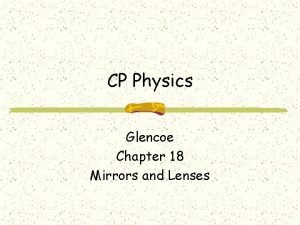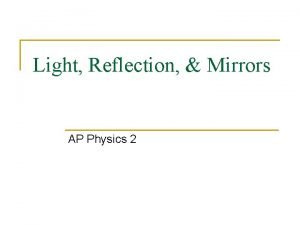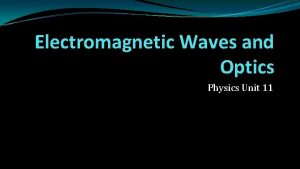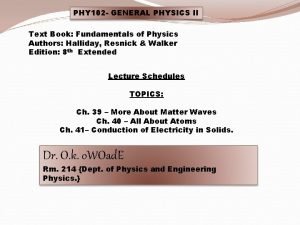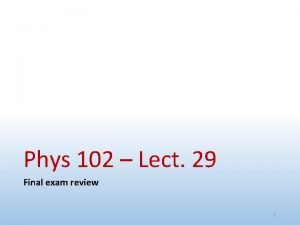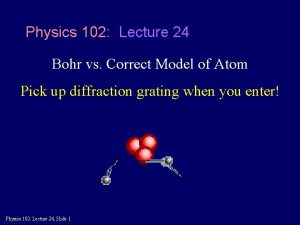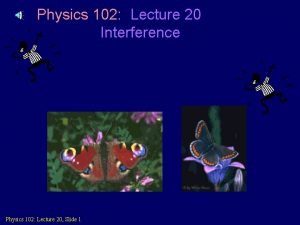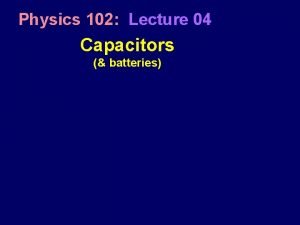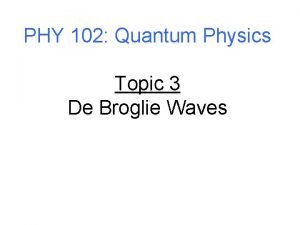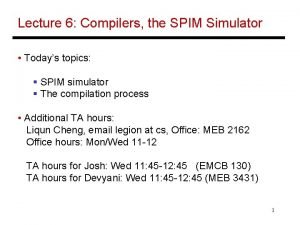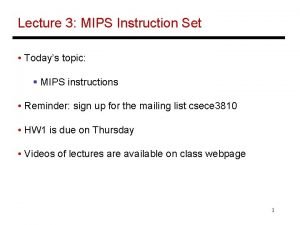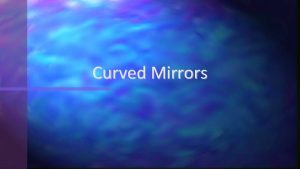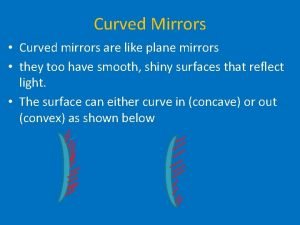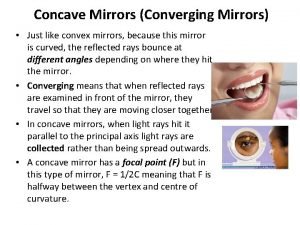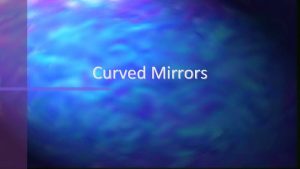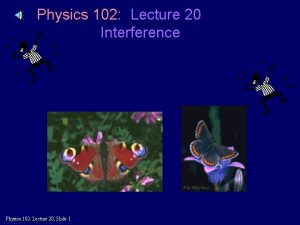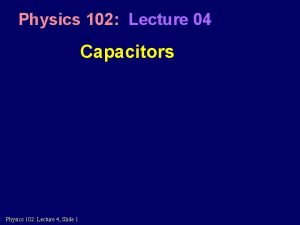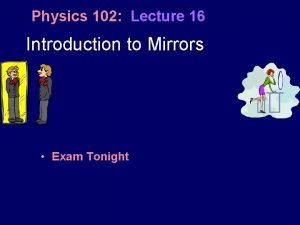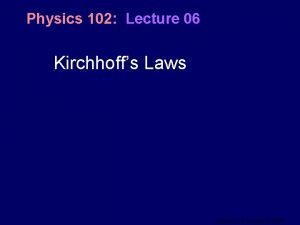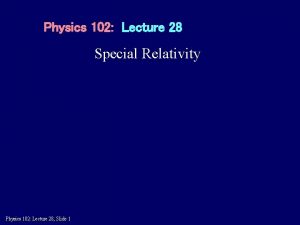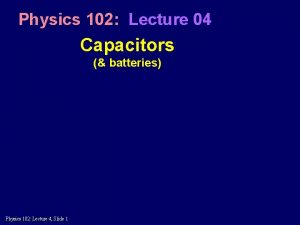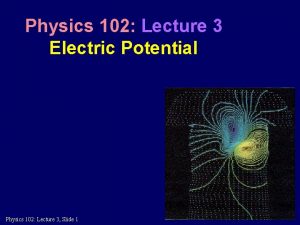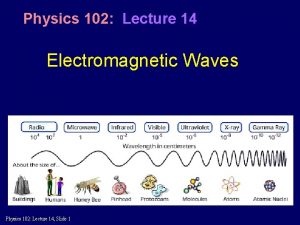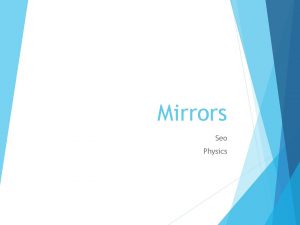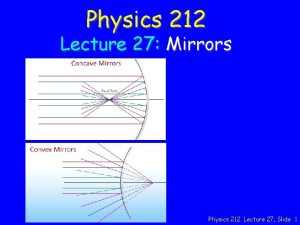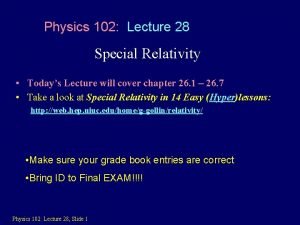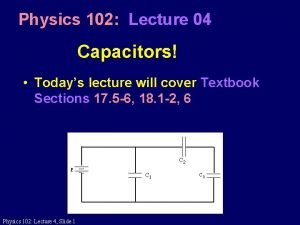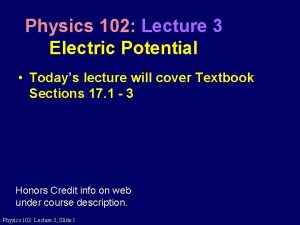Physics 102 Lecture 16 Introduction to Mirrors Todays


























- Slides: 26

Physics 102: Lecture 16 Introduction to Mirrors • Today’s lecture will cover Textbook Sections 23. 1 -2, 7 -8 Physics 102: Lecture 16, Slide 1

Light incident on an object • Absorption • Reflection (bounces)** – See it – Mirrors • Refraction (bends) – Lenses • Often some of each Everything true for wavelengths << object size

Reflection Angle of incidence = Angle of reflection qi = qr (Angles between light beam and normal) qi qr Physics 102: Lecture 16, Slide 3

Object Location • Light rays from sun bounce off object and go in all directions – Some hit your eyes We know object’s location by where rays come from. • Color: some light is absorbed by object before bouncing off. Physics 102: Lecture 16, Slide 4

Flat Mirror • All you see is what reaches your eyes – You think object’s location is where rays appear to come from. Smooth Mirror qr qi All rays originating from peak will appear to come from same point behind mirror! Object Physics 102: Lecture 16, Slide 5 Image

Flat Mirror (1) Draw first ray perpendicular to mirror 0 = qi = qr (2) Draw second ray at angle. qi = qr (3) Lines appear to intersect a distance d behind mirror. This is the image location. Light rays don’t really converge there, so it’s a “_______” Physics 102: Lecture 16, Slide 6 d

Flat Mirror (1) Draw first ray perpendicular to mirror 0 = qi = qr (2) Draw second ray at angle. qi = qr (3) Lines appear to intersect a distance d behind mirror. This is the image location. Light rays don’t really converge there, so it’s a “Virtual Image” Virtual: No light actually gets here qr qi Physics 102: Lecture 16, Slide 7 d d

Flat Mirror Summary • Image appears: – – – Upright Same size Located same distance from, but behind, mirror Facing opposite direction: Left/Right inverted Virtual Image: Light rays don’t actually intersect at image location. Preflight 16. 1 • Why do ambulances have “AMBULANCE” written backwards? Physics 102: Lecture 16, Slide 8

Flat Mirror Summary • Image appears: – – – Upright Same size Located same distance from, but behind, mirror Facing opposite direction: Left/Right inverted Virtual Image: Light rays don’t actually intersect at image location. Preflight 16. 1 • Why do ambulances have “AMBULANCE” written backwards? So you can read it in your rear-view mirror! Physics 102: Lecture 16, Slide 9

Preflight 16. 3 Can you see Fido’s tail in mirror? mirror (You) Physics 102: Lecture 16, Slide 10 (Fido)

Preflight 16. 3 Can you see Fido’s tail in mirror? mirror (You) Physics 102: Lecture 16, Slide 11 (Fido) No! You need light rays from the tail to bounce off mirror and reach your eye!

ACT: Flat Mirrors You are standing in front of a short flat mirror which is placed too high, so you can see above your head, but only down to your knees. To see your shoes, you must move (1) (2) (3) closer to the mirror. further from the mirror. to another mirror. Physics 102: Lecture 16, Slide 12

ACT: Flat Mirrors You are standing in front of a short flat mirror which is placed too high, so you can see above your head, but only down to your knees. To see your shoes, you must move (1) (2) (3) closer to the mirror. further from the mirror. to another mirror. Physics 102: Lecture 16, Slide 13 Changing distance doesn’t change what you see of yourself

Two Mirrors How many images of money will you see (not including the actual money)? Physics 102: Lecture 16, Slide 14

Two Mirrors How many images of money will you see (not including the actual money)? 2 Homework lets you quantify positions of the money. Physics 102: Lecture 16, Slide 15 1 3

Curved mirrors A Spherical Mirror: section of a sphere. Concave mirror light ray R • C principal axis R Convex mirror R light ray principal axis C = Center of curvature In front of concave mirror, behind convex mirror. Physics 102: Lecture 16, Slide 16 • C

Preflight 16. 2 An organic chemistry student accidentally drops a glass marble into a silver nitrate mirroring solution, making the outside of the marble reflective. What kind of mirror is this? (1) concave (2) convex (3) flat Physics 102: Lecture 16, Slide 17

Preflight 16. 2 An organic chemistry student accidentally drops a glass marble into a silver nitrate mirroring solution, making the outside of the marble reflective. What kind of mirror is this? (1) concave (2) convex (3) flat Physics 102: Lecture 16, Slide 18

Concave Mirror R Principal Axis Focus f=R/2 Rays are bent towards the principal axis. Rays parallel to principal axis and near the principal axis (“paraxial rays”) all reflect so they pass through the “Focus” (F). The distance from F to the center of the mirror is called the “Focal Length” (f). Physics 102: Lecture 16, Slide 19

Preflight 16. 4, 16. 5 What kind of spherical mirror can be used to start a fire? concave convex How far from the paper to be ignited should the mirror be held? farther than the focal length closer than the focal length at the focal length Physics 102: Lecture 16, Slide 20

Preflight 16. 4, 16. 5 What kind of spherical mirror can be used to start a fire? concave convex How far from the paper to be ignited should the mirror be held? farther than the focal length closer than the focal length at the focal length Physics 102: Lecture 16, Slide 21

Concave Mirror F Principal Axis F Rays traveling through focus before hitting mirror are reflected parallel to Principal Axis. Rays traveling parallel to Principal Axis before hitting mirror are reflected through focus Physics 102: Lecture 16, Slide 22

Convex Mirror R Principal Axis Focus f=-R/2 Rays are bent away from the principal axis. Rays parallel to principal axis and near the principal axis (“paraxial rays”) all reflect so they appear to originate from the “Focus” (F). The distance from F to the center of the mirror is called the “Focal Length” (f). Physics 102: Lecture 16, Slide 23

ACT: Mirror Focal Lengths A concave mirror has a positive focal length f > 0 A convex mirror has a negative focal length f < 0 What is the focal length of a flat mirror? (1) f =0 Physics 102: Lecture 16, Slide 24 (2) f = ∞

ACT: Mirror Focal Lengths A concave mirror has a positive focal length f > 0 A convex mirror has a negative focal length f < 0 What is the focal length of a flat mirror? (1) f =0 (2) f = ∞ The flatter the mirror, the larger the radius of curvature, (e. g. the earth is round, but looks flat) Physics 102: Lecture 16, Slide 25

See you later! • Read Textbook Sections: 23. 3, 8 Physics 102: Lecture 16, Slide 26
 Physics classroom lenses and mirrors
Physics classroom lenses and mirrors Ap physics 2 mirrors and lenses
Ap physics 2 mirrors and lenses Physics 11-06 image formation by mirrors
Physics 11-06 image formation by mirrors Physics 102
Physics 102 Uiuc phys 102
Uiuc phys 102 Physics 102
Physics 102 Physics 102 final exam
Physics 102 final exam Physics 102
Physics 102 Physics 102
Physics 102 Physics 102
Physics 102 Physics 102
Physics 102 Physics 102
Physics 102 01:640:244 lecture notes - lecture 15: plat, idah, farad
01:640:244 lecture notes - lecture 15: plat, idah, farad Csc 102 pdf
Csc 102 pdf Classical mechanics
Classical mechanics Physics 101 lecture notes pdf
Physics 101 lecture notes pdf Physics 101 lecture 1
Physics 101 lecture 1 Physics 101 lecture notes pdf
Physics 101 lecture notes pdf Physics waves notes pdf
Physics waves notes pdf Atmospheric physics lecture notes
Atmospheric physics lecture notes Generations
Generations In todays class
In todays class Todays with apostrophe
Todays with apostrophe Todays worldld
Todays worldld What is todays temperature
What is todays temperature Todays globl
Todays globl Whats todays wordlw
Whats todays wordlw
